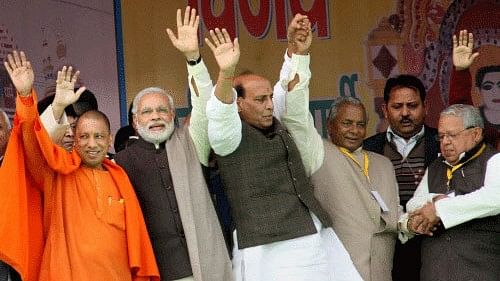
The BJP is now critically dependent on its two mercurial partners — Chandra Babu Naidu’s TDP, and Nitish Kumar’s Janata Dal (United).
Credit: PTI File Photo
The people of India have spoken. The National Democratic Alliance (NDA), led by Prime Minister Narendra Modi, has barely managed to win a majority, with the Bharatiya Janata Party (BJP) at 240 well short of the 272-majority mark. The Congress-led I.N.D.I.A. bloc is at 234, six seats short of BJP’s tally.
The BJP is now critically dependent on its two mercurial partners — Chandra Babu Naidu’s Telugu Desam Party (TDP), and Nitish Kumar’s Janata Dal (United). Naidu and Kumar are masters of statecraft, have their big grudges, and are known to drive hard bargains. They may even switch sides to I.N.D.I.A., unless the BJP offers lucrative deals while forming the next government.
Their switch can convert the NDA’s marginal lead into an I.N.D.I.A. government. At this moment, therefore, there are four possible scenarios for the new government.
First, the NDA forms the government under Modi’s leadership. Second, the NDA forms the government under a BJP leader other than Modi. Third, the NDA government will have a non-BJP prime minister. Fourth, the I.N.D.I.A. bloc, with post-poll alliance support, forms the government at the Centre.
Whichever government finally emerges will face serious challenges in formulating economic policies and programmes.
Trophy capitalism will lose
Modi’s second term witnessed the government’s capital expenditure (capex) going through the roof, wrecking fiscal discipline, thus resulting in a big debt mountain.
This capex did generate many trophies, particularly in the Railways — Vande Bharat trains, Dedicated Freight Corridors, unfinished High-Speed Rail, etc. Their economic contribution though was abysmal with the Railways’ share of passenger, freight, and gross value added going down further.
The capex in the roadways sector did make a much better economic contribution but came at a high cost making the NHAI bankrupt and the government suffering large capital losses while monetising road assets.
The worst capex was making equity investments in zombie public sector enterprises such as the BSNL, which saw large-scale debt-funded resources getting thrown down the drain.
High profile production-linked incentive (PLI) schemes, designed to transfer taxpayers’ resources to India’s billionaires, also generated a false sense of polishing capex in the private sector.
India’s debt-funded unproductive capex would have to be scaled down and replaced by better infrastructure financing models, irrespective of whichever government emerges.
Welfare spending will increase
The Modi government had different welfare strategies in its first and second terms.
The first term (Modi 1.0) programmes financed life-changing social investments such as housing, toilets, electricity, cooking gas, and health insurance, which brought enormous benefits to millions of poor people.
In contrast, Modi 2.0 fell for populist freebies — cash transfers to farmers (PMKISAN), free foodgrains supply to over 810 million people, and making fertilisers virtually costless. Modi also announced many freebies guarantees during state elections in Madhya Pradesh, Chhattisgarh, and Rajasthan.
The Modi government had an unviable implementation track-record for life-changing welfare schemes in its first term. In its second term, however, it failed to effectively deliver the only new scheme — tap water in every home, leaving millions of homes still without tap water.
While the successful delivery of life-changing development programmes of the first term turned millions of Labharthis into BJP voters in 2019, the second term freebies and botched implementation turned the poor into I.N.D.I.A. voters in many states.
The I.N.D.I.A. bloc’s principal campaign plank was more cash benefits to the poor (e.g. the Mahalakshmi scheme), which were promised to be delivered without any delay.
The NDA would find it impossible to move away from its second-term freebie opiate. If I.N.D.I.A. forms the government, it would continue all the Modi 2.0 freebie schemes and add its own, easily doubling fiscal-draining expenditures.
Continued neglect of environmental emergency
India is facing a pollution emergency. It is the most air-polluted country in the world. Our ponds, lakes, and rivers are gasping for life. However, pollution control was not the campaign issue of any political party.
Governments neglect this vital public good. They spend only about a thousand crore rupees on all its pollution control programmes.
Carbon emissions get more headlines because of international attention to control the rise in global temperatures. The Indian government also make good noises — Net Zero by 2070, 500 Gigawatt of renewal power by 2030, and so on. It, however, spends much less than what is required.
While it is important for the government to focus on both pollution and carbon emissions by expanding public expenditure programmes, as neither the NDA nor I.N.D.I.A. have made it a poll issue, it is unlikely that India’s new government will make this a priority.
Significant change in non-economic space
With the limitations of hounding out the political and business opponents through investigative agencies becoming clearer, there is a good likelihood of these agencies being reined in, particularly if Modi does not lead the new government. If an I.N.D.I.A. government is formed, there will be a considerable rollback of the draconian powers conferred on the enforcement directorate.
The Modi government staffed India’s sovereign institutions with its loyalists, which probably contributed to the undermining of Modi 2.0. The bureaucrats, regulators, and others began telling Modi what he wanted to hear, thus creating a false image of India doing unprecedentedly well. The exit polls also seemed to have fallen victim to this confirmation bias.
It will be necessary to restore the independence and vitality of these institutions. Otherwise, India might well be in for considerable chaos in the non-economic arena as well, which will also, without doubt, impact India’s economic progress.
(Subhash Chandra Garg is former Finance & Economic Affairs Secretary, and author of ‘The Ten Trillion Dream’ and ‘We Also Make Policy’.)
Disclaimer: The views expressed above are the author's own. They do not necessarily reflect the views of DH.